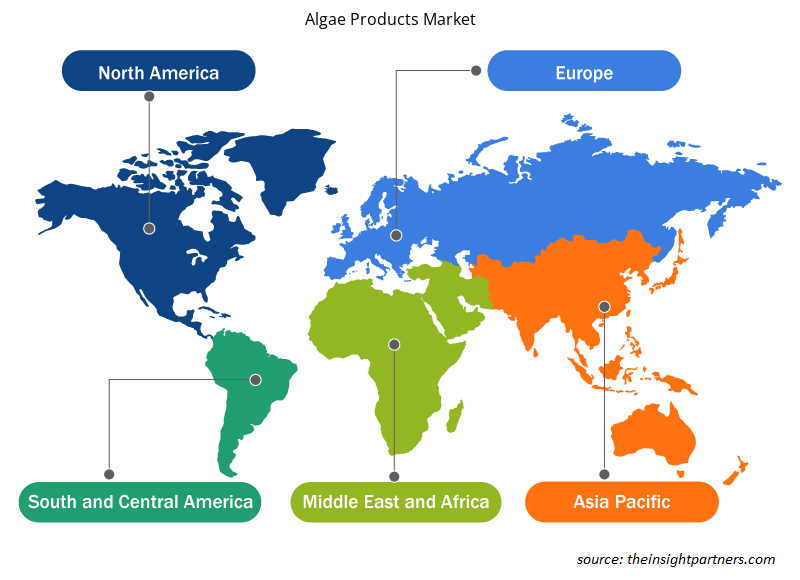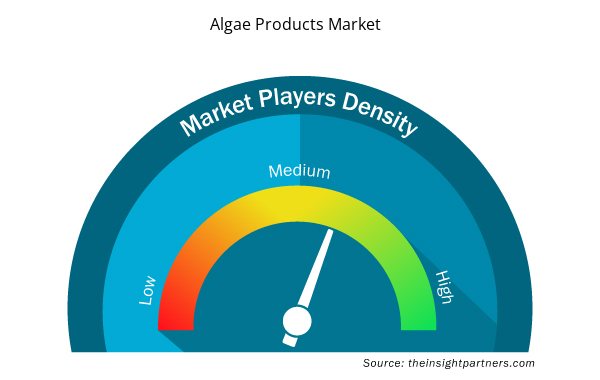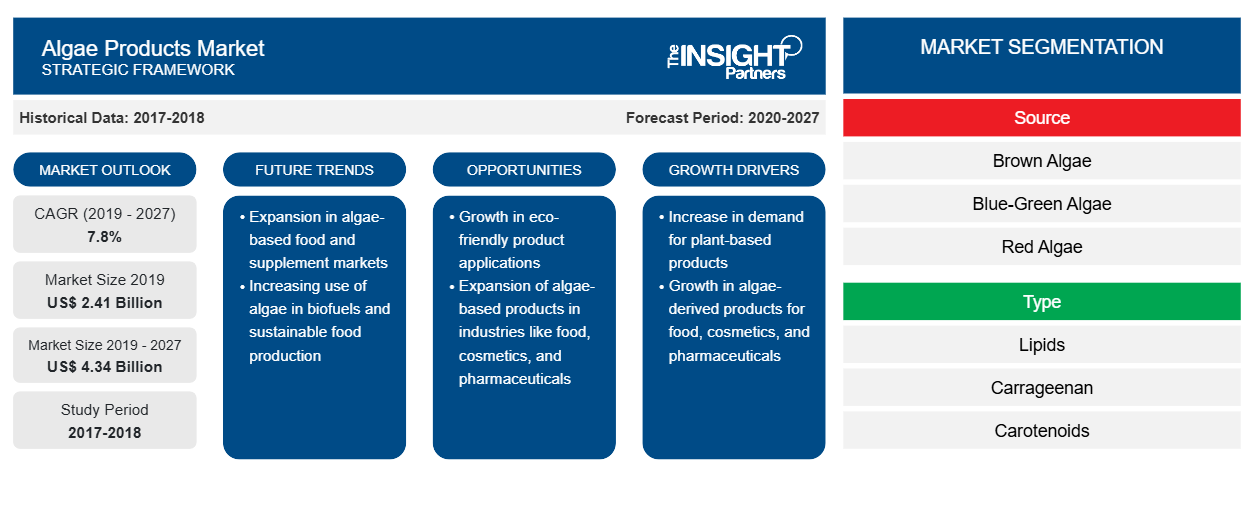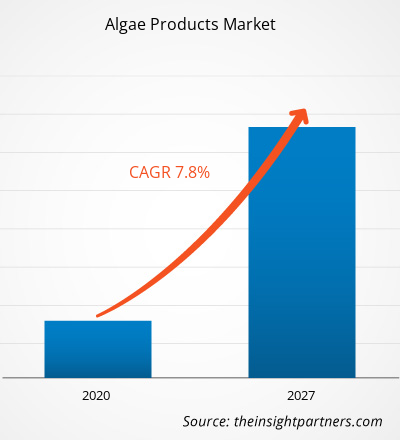[Forschungsbericht] Der Markt für Algenprodukte wurde im Jahr 2019 auf 2.405,5 Millionen US-Dollar geschätzt und soll bis 2027 4.339,3 Millionen US-Dollar erreichen; von 2020 bis 2027 wird ein durchschnittliches jährliches Wachstum von 7,8 % erwartet.
Algen entwickeln sich aufgrund ihrer zahlreichen Vorteile und ihrer einfachen Produktion zu einer der vielversprechendsten langfristigen und nachhaltigen Quellen für Kraftstoff, Nahrungsmittel, Futtermittel und andere Nebenprodukte für Biomasse und Öle. Algen haben sich im Laufe von über einer Milliarde Jahren so entwickelt, dass sie Energie effizient produzieren und speichern können, anders als jeder andere bekannte natürliche oder künstliche Prozess. Darüber hinaus können Mikroalgen mit hohem Protein- und Ölgehalt gezüchtet werden, um entweder Biokraftstoffe oder Tierfutter oder beides zu produzieren. Darüber hinaus wird Mikroalgenbiomasse, die reich an Mikronährstoffen ist, bereits für Nahrungsergänzungsmittel zur Verbesserung der menschlichen Gesundheit verwendet. Die wichtigste Anwendung auf dem Lebensmittelmarkt ist die Verwendung der gesamten Mikroalgenbiomasse als Nahrungsergänzungsmittel. Mikroalgen werden auch als Quelle für Lebensmittelzutaten verwendet, darunter Carotinoide und Omega-3-Fettsäuren. In ähnlicher Weise wird Agar in der Lebensmittelindustrie als Gelatineersatz verwendet und zur Herstellung von Cremes, Saucen, Mayonnaise, Gelees, Vanillepuddings, Puddings, Schmelzkäse und gefrorenen Milchprodukten eingesetzt. Es wird auch in Marmelade und Konfitüre zum Gelieren und Andicken und als Anti-Trocknungsmittel in Brot und Gebäck verwendet. Darüber hinaus wird Agar als Verdickungsmittel in Eiscreme und anderen Desserts verwendet. Somit dienen Algenprodukte als alternative Nahrungsquelle und Lebensmittelzutat und treiben das Wachstum des Marktes für Algenprodukte voran .
Nordamerika hatte 2019 den größten Marktanteil. Darüber hinaus wird für den asiatisch-pazifischen Raum im Prognosezeitraum 2020–2027 ein lukratives Wachstum erwartet. In den USA und anderen Teilen der Welt werden Algen häufig als Nahrungsergänzungsmittel verwendet, um das Immunsystem zu stärken, Nervengewebe zu reparieren, den Blutzucker zu normalisieren und dem Körper zusätzliche Proteine und Ballaststoffe zuzuführen. In China und Japan werden Algen seit mehr als 4.000 Jahren als Nahrungsmittel für den Menschen geerntet.
Passen Sie diesen Bericht Ihren Anforderungen an
Sie erhalten kostenlos individuelle Anpassungen an jedem Bericht, einschließlich Teilen dieses Berichts oder einer Analyse auf Länderebene, eines Excel-Datenpakets sowie tolle Angebote und Rabatte für Start-ups und Universitäten.
- Holen Sie sich die wichtigsten Markttrends aus diesem Bericht.Dieses KOSTENLOSE Beispiel umfasst eine Datenanalyse von Markttrends bis hin zu Schätzungen und Prognosen.
Auswirkungen der COVID-19-Pandemie auf den Markt für Algenprodukte
Die USA haben im Vergleich zu Kanada und Mexiko die höchste Zahl bestätigter Coronavirus-Fälle. Die Pandemie COVID-19 erzwingt weiterhin die vorübergehende Schließung von Einzelhandelsgeschäften und Produktionsstätten in den Ländern Nordamerikas, was auf eine beispiellose Unterbrechung des Handels hindeutet. Einzelhändler und Marken stehen vor verschiedenen kurzfristigen Herausforderungen in Bezug auf Gesundheit und Sicherheit, Lieferkette, Arbeitskräfte, Cashflow, Verbrauchernachfrage und Marketing. In Nordamerika begannen die Geschäfte Anfang März zu schließen, und dieser Trend dürfte sich fortsetzen, da Städte und Staaten darum kämpfen, die Ausbreitung des Virus einzudämmen. Darüber hinaus beschleunigt die COVID-19-Pandemie die Tradition des digitalen Handels rasant. Da den Menschen geraten wird, soziale Distanz zu wahren, sind E-Commerce-Bestellungen von Medikamenten und lebenswichtigen Lebensmitteln und Getränken zu einem Überlebensinstrument für die Menschen in Nordamerika geworden.
Markteinblicke
Exponentielles Wachstum im Biokraftstoffmarkt
Im letzten Jahrzehnt hatte die Algenindustrie Mühe, den Biokraftstoffmarkt aufrechtzuerhalten. Das Produkt hat jedoch das Potenzial, enormes Potenzial zu entfalten, sobald die Hersteller die kritischen Hürden im Zusammenhang mit der Rohstoffherstellung, den Kapitalkosten und den Produktionsmengen überwunden haben. Die weltweite Einführung von Biokraftstoffvorschriften wird die Hersteller voraussichtlich dazu zwingen, im Prognosezeitraum mehr in Forschung und Entwicklung zu investieren, um eine nachhaltige Technologie für die Produktion von Algenkraftstoff zu entwickeln. Darüber hinaus gelten Biokraftstoffe als eine der vielversprechendsten potenziellen Quellen erneuerbarer Energie zur Lösung der globalen Energiekrise und der Umweltprobleme. Mikroalgenbiomasse hat gezeigt, dass sie in der Lage ist, Biokraftstoffe, Chemikalien und biobasierte Güter zu verarbeiten und so zum Übergang von einer erdölbasierten zu einer biobasierten Wirtschaft beizutragen. Algenbiokraftstoff bietet Vorteile wie eine höhere Wachstumsrate ohne Nahrungsmittelkonkurrenz und minimale oder keine Umweltauswirkungen. Aus Mikroalgen hergestellter Biokraftstoff hat im Vergleich zu Zellulosebiokraftstoff mit hohem Brennwert eine niedrige Viskosität und Dichte, wodurch Algenbiokraftstoff für diese Anwendung besser geeignet ist.
Quellenbasierte Markteinblicke
Quellen zufolge ist der Markt für Algenprodukte in Braunalgen, Blaualgen, Rotalgen, Grünalgen und andere unterteilt. Das Segment Braunalgen war 2019 führend auf dem Markt für Algenprodukte.
Typbasierte Markteinblicke
Der Markt für Algenprodukte ist nach Typ in Lipide, Carrageen, Carotinoide, Alginat, Algenprotein und andere unterteilt. Das Segment der Carotinoide führte den Markt für Algenprodukte im Jahr 2019 an
Formularbasierte Markteinblicke
Der Markt für Algenprodukte ist je nach Form in fest und flüssig unterteilt. Das feste Segment war 2019 der führende Markt für Algenprodukte.
Anwendungsbasierte Markteinblicke
Der Markt für Algenprodukte ist je nach Anwendung in Lebensmittel und Getränke, Nutraceutika und Nahrungsergänzungsmittel, Körperpflegeprodukte, Futtermittel, Arzneimittel und andere unterteilt. Das Segment Nutraceutika und Nahrungsergänzungsmittel führte den Markt für Algenprodukte im Jahr 2019 an
Organische Wachstumsstrategien sind die von Unternehmen am häufigsten angewandten Strategien zur Ausweitung ihrer Marktreichweite. Cyanotech Corporation, DSM und Algatech Ltd gehören zu den Marktteilnehmern, die diese Strategie umsetzen, um den Kundenstamm zu vergrößern und weltweit bedeutende Marktanteile zu gewinnen, was ihnen wiederum ermöglicht, ihren Markennamen auf dem globalen Markt für Algenprodukte zu behaupten.
Regionale Einblicke in den Markt für Algenprodukte
Die regionalen Trends und Faktoren, die den Markt für Algenprodukte während des Prognosezeitraums beeinflussen, wurden von den Analysten von Insight Partners ausführlich erläutert. In diesem Abschnitt werden auch die Marktsegmente und die Geografie von Algenprodukten in Nordamerika, Europa, im asiatisch-pazifischen Raum, im Nahen Osten und Afrika sowie in Süd- und Mittelamerika erörtert.

- Erhalten Sie regionale Daten zum Markt für Algenprodukte
Umfang des Marktberichts zu Algenprodukten
| Berichtsattribut | Details |
|---|---|
| Marktgröße im Jahr 2019 | 2,41 Milliarden US-Dollar |
| Marktgröße bis 2027 | 4,34 Milliarden US-Dollar |
| Globale CAGR (2019 - 2027) | 7,8 % |
| Historische Daten | 2017-2018 |
| Prognosezeitraum | 2020–2027 |
| Abgedeckte Segmente | Nach Quelle
|
| Abgedeckte Regionen und Länder | Nordamerika
|
| Marktführer und wichtige Unternehmensprofile |
|
Marktteilnehmerdichte für Algenprodukte: Auswirkungen auf die Geschäftsdynamik verstehen
Der Markt für Algenprodukte wächst rasant, angetrieben durch die steigende Nachfrage der Endverbraucher aufgrund von Faktoren wie sich entwickelnden Verbraucherpräferenzen, technologischen Fortschritten und einem größeren Bewusstsein für die Vorteile des Produkts. Mit steigender Nachfrage erweitern Unternehmen ihr Angebot, entwickeln Innovationen, um die Bedürfnisse der Verbraucher zu erfüllen, und nutzen neue Trends, was das Marktwachstum weiter ankurbelt.
Die Marktteilnehmerdichte bezieht sich auf die Verteilung der Firmen oder Unternehmen, die in einem bestimmten Markt oder einer bestimmten Branche tätig sind. Sie gibt an, wie viele Wettbewerber (Marktteilnehmer) in einem bestimmten Marktraum im Verhältnis zu seiner Größe oder seinem gesamten Marktwert präsent sind.
Die wichtigsten auf dem Markt für Algenprodukte tätigen Unternehmen sind:
- Algatech LTD
- Algenol
- BASF SE
- Cargill, Incorporated
- Cellana Inc.
Haftungsausschluss : Die oben aufgeführten Unternehmen sind nicht in einer bestimmten Reihenfolge aufgeführt.

- Überblick über die wichtigsten Akteure auf dem Markt für Algenprodukte
Algenprodukte-Marktsegmentierung:
Markt für Algenprodukte – nach Quelle
- Braunalgen
- Blaualgen
- Rote Algen
- Grüne Algen
- Sonstiges
Markt für Algenprodukte – nach Typ
- Lipide
- Carrageen
- Carotinoide
- Alginat
- Algenprotein
- Sonstiges
Markt für Algenprodukte – nach Form
- Solide
- Flüssig
Markt für Algenprodukte – nach Anwendung
- Essen und Trinken
- Nutraceuticals und Nahrungsergänzungsmittel
- Körperpflegeprodukte
- Füttern
- Pharmazeutika
- Andere
Firmenprofile
- Algatechnologies Ltd
- Algenol
- BASF SE
- Cargill Incorporated.
- Cellana Inc.
- Corbion nv
- CP Kelco (JM Huber-Corporation
- Cyanotech Corporation.
- DSM Nutritional Products AG
- EID Parry Limited
- Historische Analyse (2 Jahre), Basisjahr, Prognose (7 Jahre) mit CAGR
- PEST- und SWOT-Analyse
- Marktgröße Wert/Volumen – Global, Regional, Land
- Branche und Wettbewerbsumfeld
- Excel-Datensatz



Report Coverage
Revenue forecast, Company Analysis, Industry landscape, Growth factors, and Trends

Segment Covered
This text is related
to segments covered.

Regional Scope
North America, Europe, Asia Pacific, Middle East & Africa, South & Central America

Country Scope
This text is related
to country scope.
Häufig gestellte Fragen
The nutraceuticals and dietary supplements segment is the leading application in the market. Seaweeds are consumed in the form of nutraceuticals and dietary supplements, and complementary medicine across global. Algae became a promising source of ecological crops with several health benefits, which includes proteins such as antioxidants and Omega 3. The nutraceuticals and pharmaceutical industries make use of a considerable variety of algae species for the development of dietary supplements that are consumed by humans.
The North America region led the global algae products market in 2019. A rapid increase in the number of health diseases, such as heart diseases and obesity, has favored the demand for vegan seafood products, which shows substantial opportunities for the algae products market in North America.
Algae are emerging as one of the most promising long-term, sustainable sources of fuel, food, feed, and other co-products for biomass and oils due to a large number of benefits and ease of its production. Algae have evolved over a billion years to efficiently produce and store energy, unlike any other known natural or engineered process. Furthermore, microalgae can be grown to have a high protein and oil content in order to produce either biofuels or animal feeds, or both. Therefore, the alternate food source and food ingredient is driving the growth of algae products market across globe.
Trends and growth analysis reports related to Food and Beverages : READ MORE..
The List of Companies - Algae Products Market
- Algatech LTD
- Algenol
- BASF SE
- Cargill, Incorporated
- Cellana Inc.
- Corbion
- CP Kelco
- Cyanotech Corporation
- DSM
- E.I.D. - Parry (India) Limited
The Insight Partners performs research in 4 major stages: Data Collection & Secondary Research, Primary Research, Data Analysis and Data Triangulation & Final Review.
- Data Collection and Secondary Research:
As a market research and consulting firm operating from a decade, we have published and advised several client across the globe. First step for any study will start with an assessment of currently available data and insights from existing reports. Further, historical and current market information is collected from Investor Presentations, Annual Reports, SEC Filings, etc., and other information related to company’s performance and market positioning are gathered from Paid Databases (Factiva, Hoovers, and Reuters) and various other publications available in public domain.
Several associations trade associates, technical forums, institutes, societies and organization are accessed to gain technical as well as market related insights through their publications such as research papers, blogs and press releases related to the studies are referred to get cues about the market. Further, white papers, journals, magazines, and other news articles published in last 3 years are scrutinized and analyzed to understand the current market trends.
- Primary Research:
The primarily interview analysis comprise of data obtained from industry participants interview and answers to survey questions gathered by in-house primary team.
For primary research, interviews are conducted with industry experts/CEOs/Marketing Managers/VPs/Subject Matter Experts from both demand and supply side to get a 360-degree view of the market. The primary team conducts several interviews based on the complexity of the markets to understand the various market trends and dynamics which makes research more credible and precise.
A typical research interview fulfils the following functions:
- Provides first-hand information on the market size, market trends, growth trends, competitive landscape, and outlook
- Validates and strengthens in-house secondary research findings
- Develops the analysis team’s expertise and market understanding
Primary research involves email interactions and telephone interviews for each market, category, segment, and sub-segment across geographies. The participants who typically take part in such a process include, but are not limited to:
- Industry participants: VPs, business development managers, market intelligence managers and national sales managers
- Outside experts: Valuation experts, research analysts and key opinion leaders specializing in the electronics and semiconductor industry.
Below is the breakup of our primary respondents by company, designation, and region:

Once we receive the confirmation from primary research sources or primary respondents, we finalize the base year market estimation and forecast the data as per the macroeconomic and microeconomic factors assessed during data collection.
- Data Analysis:
Once data is validated through both secondary as well as primary respondents, we finalize the market estimations by hypothesis formulation and factor analysis at regional and country level.
- Macro-Economic Factor Analysis:
We analyse macroeconomic indicators such the gross domestic product (GDP), increase in the demand for goods and services across industries, technological advancement, regional economic growth, governmental policies, the influence of COVID-19, PEST analysis, and other aspects. This analysis aids in setting benchmarks for various nations/regions and approximating market splits. Additionally, the general trend of the aforementioned components aid in determining the market's development possibilities.
- Country Level Data:
Various factors that are especially aligned to the country are taken into account to determine the market size for a certain area and country, including the presence of vendors, such as headquarters and offices, the country's GDP, demand patterns, and industry growth. To comprehend the market dynamics for the nation, a number of growth variables, inhibitors, application areas, and current market trends are researched. The aforementioned elements aid in determining the country's overall market's growth potential.
- Company Profile:
The “Table of Contents” is formulated by listing and analyzing more than 25 - 30 companies operating in the market ecosystem across geographies. However, we profile only 10 companies as a standard practice in our syndicate reports. These 10 companies comprise leading, emerging, and regional players. Nonetheless, our analysis is not restricted to the 10 listed companies, we also analyze other companies present in the market to develop a holistic view and understand the prevailing trends. The “Company Profiles” section in the report covers key facts, business description, products & services, financial information, SWOT analysis, and key developments. The financial information presented is extracted from the annual reports and official documents of the publicly listed companies. Upon collecting the information for the sections of respective companies, we verify them via various primary sources and then compile the data in respective company profiles. The company level information helps us in deriving the base number as well as in forecasting the market size.
- Developing Base Number:
Aggregation of sales statistics (2020-2022) and macro-economic factor, and other secondary and primary research insights are utilized to arrive at base number and related market shares for 2022. The data gaps are identified in this step and relevant market data is analyzed, collected from paid primary interviews or databases. On finalizing the base year market size, forecasts are developed on the basis of macro-economic, industry and market growth factors and company level analysis.
- Data Triangulation and Final Review:
The market findings and base year market size calculations are validated from supply as well as demand side. Demand side validations are based on macro-economic factor analysis and benchmarks for respective regions and countries. In case of supply side validations, revenues of major companies are estimated (in case not available) based on industry benchmark, approximate number of employees, product portfolio, and primary interviews revenues are gathered. Further revenue from target product/service segment is assessed to avoid overshooting of market statistics. In case of heavy deviations between supply and demand side values, all thes steps are repeated to achieve synchronization.
We follow an iterative model, wherein we share our research findings with Subject Matter Experts (SME’s) and Key Opinion Leaders (KOLs) until consensus view of the market is not formulated – this model negates any drastic deviation in the opinions of experts. Only validated and universally acceptable research findings are quoted in our reports.
We have important check points that we use to validate our research findings – which we call – data triangulation, where we validate the information, we generate from secondary sources with primary interviews and then we re-validate with our internal data bases and Subject matter experts. This comprehensive model enables us to deliver high quality, reliable data in shortest possible time.


 Holen Sie sich ein kostenloses Muster für diesen Bericht
Holen Sie sich ein kostenloses Muster für diesen Bericht